How to Make Your Own Natural Bee Smoker Fuel
Trade unpleasantly savory smoke for something a little more sweet and pleasant.
How to Make Your Own Natural Bee Smoker Fuel
Trade unpleasantly savory smoke for something a little more sweet and pleasant.
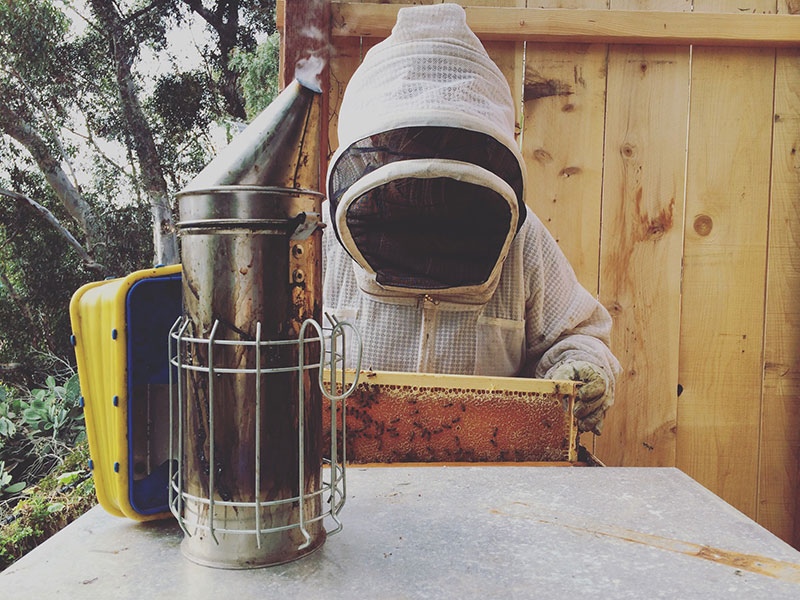
The good news is there is a simple way to improve the inadvertent perfume. It starts with choosing a different kind of fuel. When smoke is made from typical materials – wood shavings, pellets, and burlap – the smell that sticks is unpleasantly savory, a mix of beef jerky and barbecue. But when the smoke is made from forest-floor pine needles or spicy embers of sage, the beekeeper’s smoky aroma is sweet and pleasant like incense. Added plus: Smoke from some organic materials, like grapefruit leaves and creosote bush, have shown promise in reducing varroa mites, according to preliminary USDA research.
Step 1: Gather Organic Materials
This project is about having fun with the bee smoker, but it’s also about avoiding waste and not needing to buy fuel.
Start by just looking around: What’s abundant in your yard? In your kitchen? Would neighbors let you gather from their yards? Is there something you’ve been throwing out that you could burn instead? Herbs like mint, sage, basil, lavender, and oregano burn with a flash of sweetness and white smoke. Eucalyptus leaves are highly flammable and have a strong medicinal scent – they are great for getting your smoker lit. Also, collect materials that are oily and hardy: citrus peels, rosemary needles, and pine needles go a long way in the smoker. And don’t toss old flower arrangements. Set aside browning roses and anything in the sunflower family (sunflowers, daisies, zinnias, etc.) to dry and put in the smoker.
But be careful: Choose organic plant-based materials – don’t burn anything that’s toxic, or contains synthetic or plastic elements. Also, many native and exotic plants produce noxious smoke and can make you feel sick. Stick to plants that are commonly eaten, used in skin care, made into home-care products, or distilled into essential oils. And remember to gather responsibly, ecologically, and lawfully, if you decide to do some wild harvesting.
Step 2: Organize Your Materials
Once you have potential plant materials identified, take note of their dominant characteristics as a fuel for a little insight into how they’ll burn. For example, leafy materials make good tinder once they’re dry. Oily or resinous plant material, like rosemary sprigs or orange peels, take a longer time to dry, but once they are, last longer in the smoker. Traditional kitchen herbs, like basil and sage, make a really sweet smelling smoke that’s light and white – almost like incense. Dry pine needles and eucalyptus leaves are the items my mentor Hilary Kearney from Girl Next Door Honey first taught me to use in the smoker. They are natural, free materials we can find almost anywhere in San Diego. They burn for a long time, so it’s the standard fuel for Girl Next Door Honey beekeeping.
Here is how I categorize a few of my favorite plants or plant materials:
| Oily or Resinous | Herby & Sweet | Other |
| Citrus Peels
Rosemary Pine Needles Eucalyptus Lavender |
Mint
Basil Oregano Sage Rose |
Cut flowers (in the rose, mint, and sunflower family)
Flowers from pruning/deadheading Dill flowers and stems Fennel flowers and stems Cilantro/coriander stems |
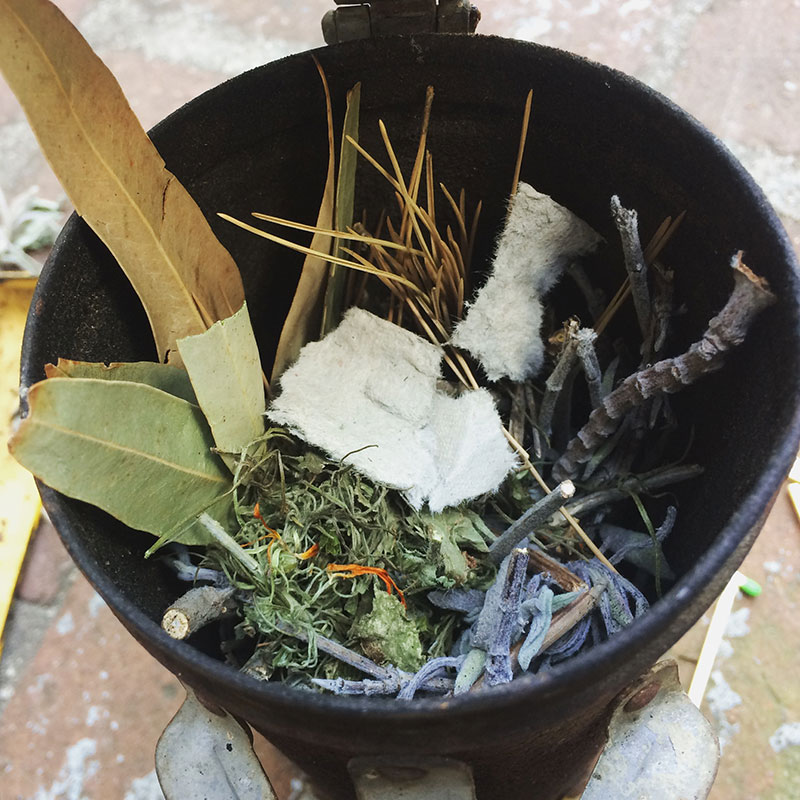
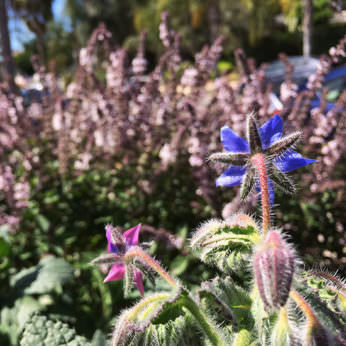
Step 3: Start Drying
Bundles: I dry herbs like oregano and lavender in bundles, hanging from a hook. Indoors or in a dry outdoor environment, this process may take more than a week. Herbs should be very dry. You’ll know they’re ready when the stems in the middle of the bundle crack and snap, and the leaves crumble between your fingers.
Stringing: I dry citrus peels by stringing them on hemp twine like bead, using a large-eye blunt needle. Drying this way may take up to two weeks. If the citrus peels snap cleanly when bent, like a cracker or piece of toast, they are dry enough.
Trays: Spread finer materials, like flower petals or basil leaves, on cookie sheets. First, break apart flowers and cut up any stems so they dry at about the same rate as the leaves. Then, leave the sheets in your gas oven to dry over the course of a few days. (The gas oven’s pilot light should provide enough gentle heat to dry the materials.) If you find that they’re not drying well, or if you have an electric oven, turn it on the warm setting for 10 to 15 minutes once or twice a day. Just like any baking project, don’t leave the materials untended while your oven is on.
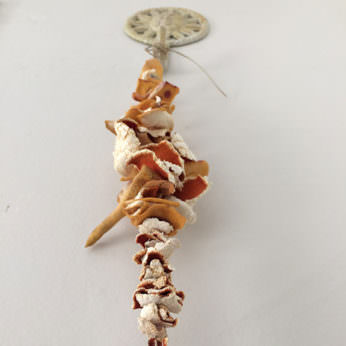

Step 4: Make Your Blends
This process is about experimenting, so don’t be afraid to create your own blend of materials. Blends can be simple with just two ingredients, or more complex with an eclectic medley of oily, herby, and aromatic material. For your first few times drying and blending, be sure to test what you have created in your smoker prior to working with the bees. See how long the items burn, if you would like to reduce or increase certain materials, and to gauge how well you like the smoke. A few trials runs will teach you a lot about the materials you have gathered and saved.

Step 5: Fold Your Packets
Save brown paper grocery bags or plain packing paper to make simple packets to hold your fuel blends. It’s okay for the paper to have some printing on it, as long as the inks are soy-based. With scissors and a few folds – and no adhesive – it is easy to make a sturdy packet, so you don’t have to burn glue or tape. There are excellent tutorials on YouTube to help with this. I’ve recently settled on a design on the Paper Kawaii YouTube channel called “Easy Origami Envelope.” I make my packets 4 to 6 inches long and big enough so that I can nestle one to two large handfuls of my blends inside. (Each handful is about a full coffee mug of material.)
You could also use small brown-paper lunch bags, which are very easy to fill and seal with just a few folds.
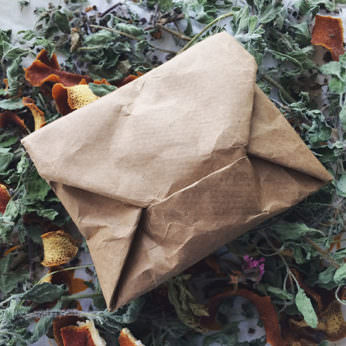
Step 6: Start Burning!
I store my envelopes in a small basket near my beekeeping equipment, where they’re handy when it’s time to gather my tools. I usually use two packets per beehive inspection, and I keep a bag of loose, dry pine needles and torn pieces of egg cartons with me as supplemental fuel. The packets can go straight into the smoker chamber after the paper has been lit on the bottom with a match. It usually takes a few squeezes of the bellows to get the flames to catch. If the packet doesn’t catch, I light a small handful of pine needles or a piece of egg carton under the packet.
Remember: Burning a noxious material or something that burns very hot can hurt the bees or singe them. Don’t overuse your smoke; one to three puffs of herbal smoke will work.
That’s it – have fun!
A version of this article originally appeared on Girl Next Door Honey’s blog, beekeepinglikeagirl.com.
Follow us
This work is licensed under a Creative Commons Attribution-NoDerivatives 4.0 International License.
Want to republish a Modern Farmer story?
We are happy for Modern Farmer stories to be shared, and encourage you to republish our articles for your audience. When doing so, we ask that you follow these guidelines:
Please credit us and our writers
For the author byline, please use “Author Name, Modern Farmer.” At the top of our stories, if on the web, please include this text and link: “This story was originally published by Modern Farmer.”
Please make sure to include a link back to either our home page or the article URL.
At the bottom of the story, please include the following text:
“Modern Farmer is a nonprofit initiative dedicated to raising awareness and catalyzing action at the intersection of food, agriculture, and society. Read more at <link>Modern Farmer</link>.”
Use our widget
We’d like to be able to track our stories, so we ask that if you republish our content, you do so using our widget (located on the left hand side of the article). The HTML code has a built-in tracker that tells us the data and domain where the story was published, as well as view counts.
Check the image requirements
It’s your responsibility to confirm you're licensed to republish images in our articles. Some images, such as those from commercial providers, don't allow their images to be republished without permission or payment. Copyright terms are generally listed in the image caption and attribution. You are welcome to omit our images or substitute with your own. Charts and interactive graphics follow the same rules.
Don’t change too much. Or, ask us first.
Articles must be republished in their entirety. It’s okay to change references to time (“today” to “yesterday”) or location (“Iowa City, IA” to “here”). But please keep everything else the same.
If you feel strongly that a more material edit needs to be made, get in touch with us at [email protected]. We’re happy to discuss it with the original author, but we must have prior approval for changes before publication.
Special cases
Extracts. You may run the first few lines or paragraphs of the article and then say: “Read the full article at Modern Farmer” with a link back to the original article.
Quotes. You may quote authors provided you include a link back to the article URL.
Translations. These require writer approval. To inquire about translation of a Modern Farmer article, contact us at [email protected]
Signed consent / copyright release forms. These are not required, provided you are following these guidelines.
Print. Articles can be republished in print under these same rules, with the exception that you do not need to include the links.
Tag us
When sharing the story on social media, please tag us using the following: - Twitter (@ModFarm) - Facebook (@ModernFarmerMedia) - Instagram (@modfarm)
Use our content respectfully
Modern Farmer is a nonprofit and as such we share our content for free and in good faith in order to reach new audiences. Respectfully,
No selling ads against our stories. It’s okay to put our stories on pages with ads.
Don’t republish our material wholesale, or automatically; you need to select stories to be republished individually.
You have no rights to sell, license, syndicate, or otherwise represent yourself as the authorized owner of our material to any third parties. This means that you cannot actively publish or submit our work for syndication to third party platforms or apps like Apple News or Google News. We understand that publishers cannot fully control when certain third parties automatically summarize or crawl content from publishers’ own sites.
Keep in touch
We want to hear from you if you love Modern Farmer content, have a collaboration idea, or anything else to share. As a nonprofit outlet, we work in service of our community and are always open to comments, feedback, and ideas. Contact us at [email protected].by Sara Everett, Modern Farmer
June 13, 2016
Modern Farmer Weekly
Solutions Hub
Innovations, ideas and inspiration. Actionable solutions for a resilient food system.
ExploreExplore other topics
Share With Us
We want to hear from Modern Farmer readers who have thoughtful commentary, actionable solutions, or helpful ideas to share.
SubmitNecessary cookies are absolutely essential for the website to function properly. This category only includes cookies that ensures basic functionalities and security features of the website. These cookies do not store any personal information.
Any cookies that may not be particularly necessary for the website to function and are used specifically to collect user personal data via analytics, ads, other embedded contents are termed as non-necessary cookies.
Any bee removal/relocators in the San Fernando valley near Los Angeles?
Have small orange orchard and honey bees to pollinate.